Category Archive for Morocco
Royal Mansour Marrakesh: world’s most luxurious hotel! 5-star Morocco riad, Michelin restaurant.
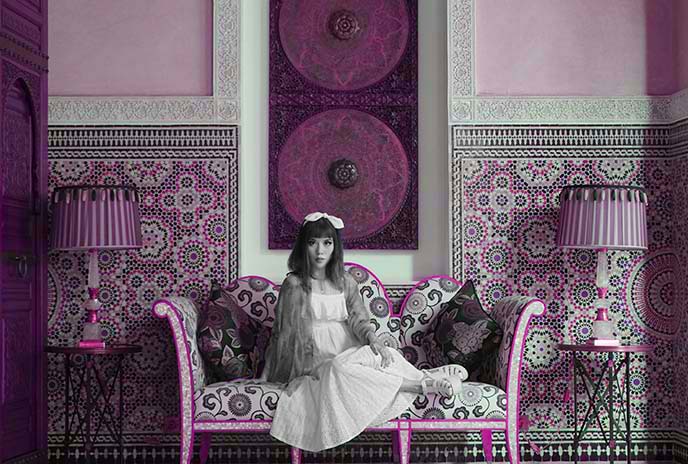
Come aboard my magic carpet, and fly with me through a Moroccan fantasy hotel: Royal Mansour Marrakesh!
My film team and I have been invited to stay at many wonderful places, but Royal Mansour was unlike anything we’d experienced. If you’re a dreamer like I am, inspired by the art and culture of Morocco, then you’ll understand why this five-star riad is so special.
(PS: don’t miss out on my current Japan travels, which you can see on my social media @lacarmina and linked in the top right sidebar.)
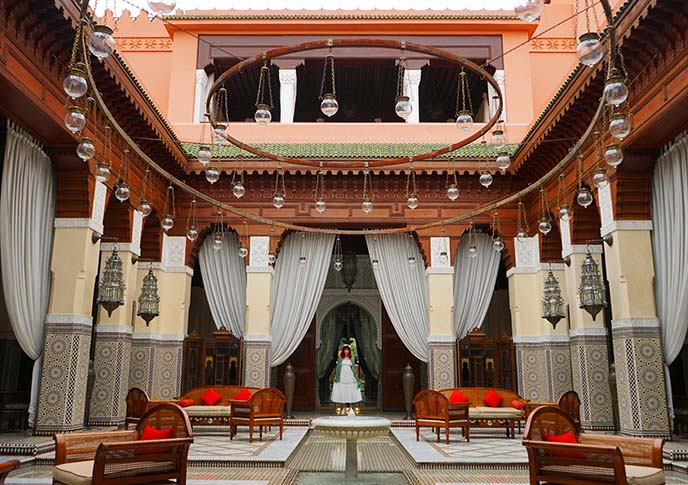
It sounds like a tale from 1001 Nights: Royal Mansour was the vision of King Mohammed VI, who employed over a thousand craftsmen and spared no expense to make this dream a reality. (Book a stay at this hotel & learn more here.)

My friends and I felt like Scheherazade, wandering the king’s palace in a daze. In a single picture, you’ll find a million details: the tiles, marble, gold, and carved arches.
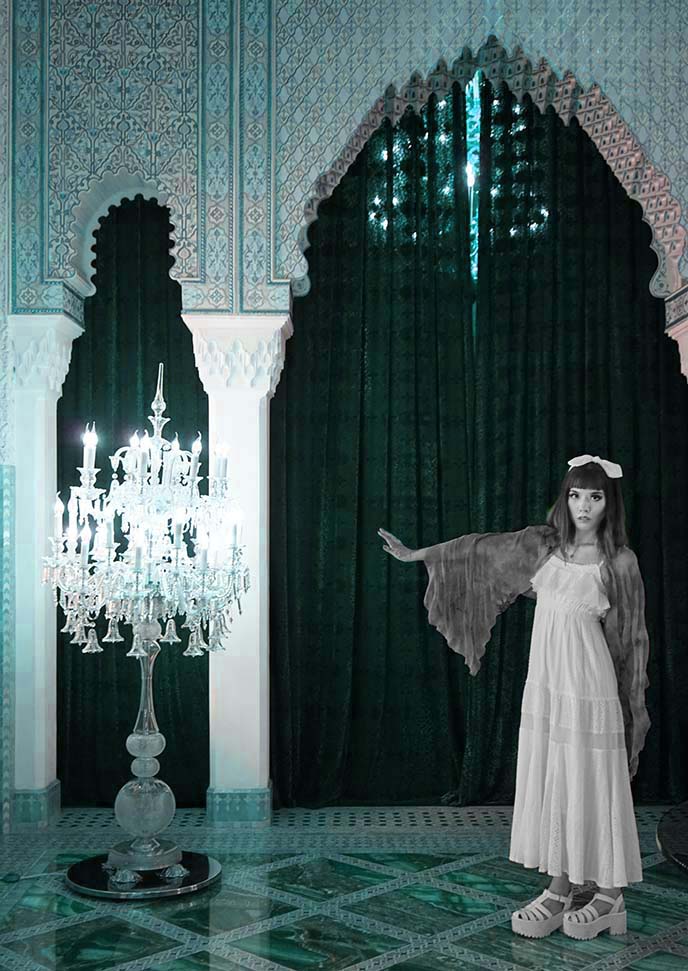
You can imagine the fun we had, exploring the riads and hidden lounges, and taking photos along the way. Each area was lit to perfection — such as this reception area with a glowing chandelier.
The space made me feel like Alice in Wonderland, so I wore a romantic white dress by Liz Lisa (I’m currently selling it on my Depop, in case you would like it!). I played around with some color edits, to emphasize details of the architecture.

Let’s start from the entrance. Marrakesh’s Royal Mansour is only minutes from the bustling Square of the Dead, but the atmosphere couldn’t have been a bigger contrast. We drove through peaceful, opulent gardens and arches until we reached the grand entrance.
An adorable “lobby girl” greeted us, wearing a red cap, military-style outfit and white gloves.
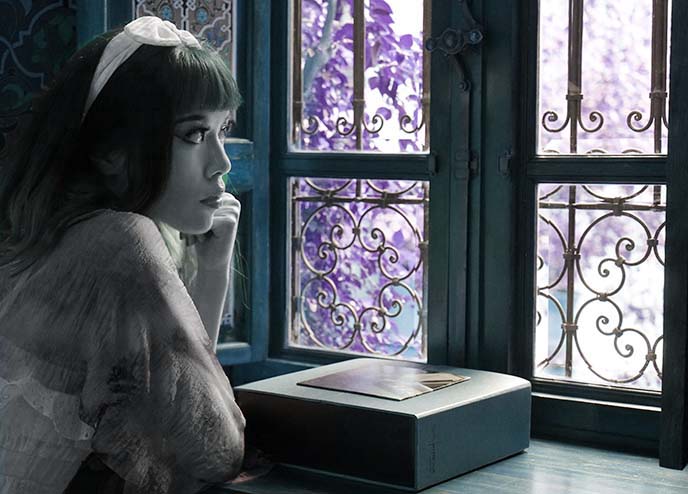
At Royal Mansour, guests don’t stay in rooms. They get their very own three-storey riad, or Moroccan house with an open courtyard.
My jaw dropped when I realized I had one of the 53 private riads all to myself. I stepped past a blue-tiled foutain, into a living room furnished with the finest furniture.

The riad was fit for a Moroccan princess: a kitchen, rooftop terrace with a swimming pool, and my own elevator. Every detail, from the antique star lamps to the cushions with glass beads, was exquisite.

My bedroom looked like an illustration from a centuries-old storybook — yet it had all the latest amenities including free movies. I spent an hour soaking in the giant marble tub that lies behind these curved wooden doors.
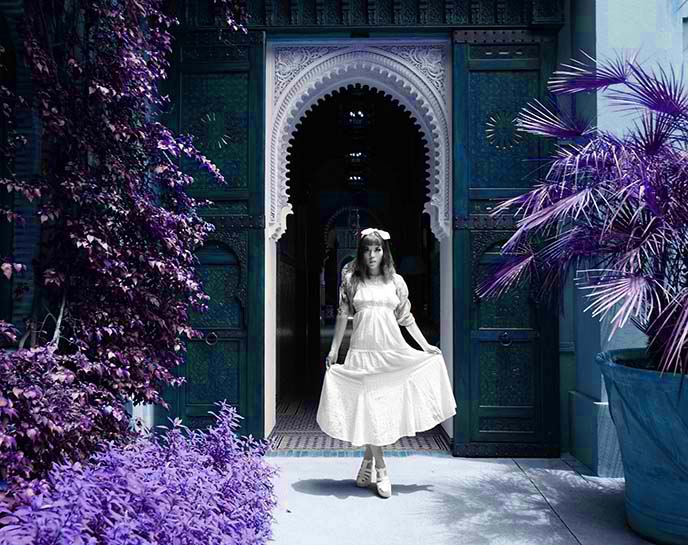
Outside, the gardens were blooming with palms, purple bougainvillea and pomegranate trees. The landscape artist – Spain’s Luis Vallejo – also designed the gardens at the Alhambra palace in Granada (which we visited).

My long white dress added to the dreamlike feeling of the space. My platform sandals are these ones by YRU.
(I’m currently selling both of these items, plus more from my closet at discounted rates. Come take a look at all my sale listings, and email me if you’d like to get anything!)

The heart of the hotel is its main courtyard, a palatial arrangement around a cross-shaped fountain.
Mohammed VI began building Royal Mansour in the 2000s, and brought in the “crème de la crème” including architecture firm OBM and the French interior designers 3BIS. He spared no expense. The total budget of the project has never been revealed.
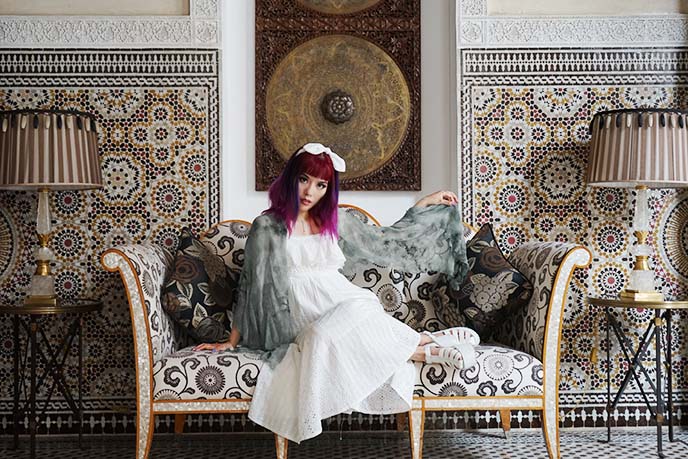
He wanted Royal Mansour to be a tribute to traditional Moroccan craftsmanship — so he hired over a thousand of the country’s best artisans. Each tile was handcut and placed, and every screen was painstakingly carved.
Imagine the effort that went into the zellige alone (the starburst-shaped mosaic wall) in the photo above…
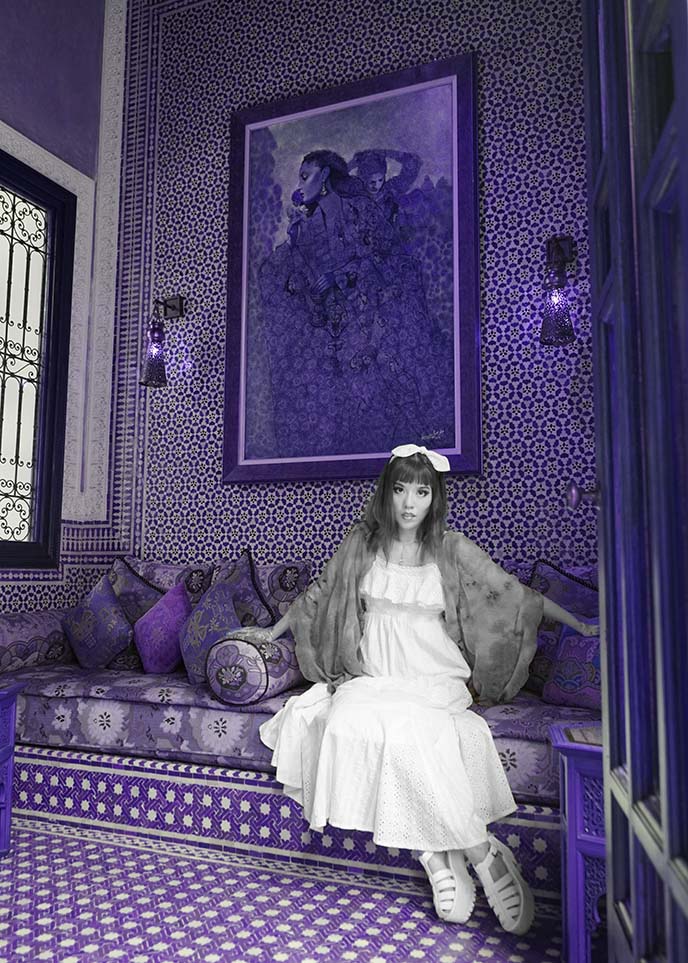
Around the courtyard, there were intimate curtained rooms filled with cushions and paintings. I ducked into this hidden space and closed my eyes, taking in the scent of jasmine and orange blossom.
I listened to birds singing from the room next door, water trickling through the courtyard, and the light strains of Berber music.

Every corner of the hotel delighted our senses, particularly the open-air courtyards. We walked up the stairwell and found libraries, cigar and cocktail lounges.
Royal Mansour is opulence in its subtlest form. The hotel never feels over-the-top, and yet each detail is pure luxury.

The King brought together the highest achievements of Moroccan culture in a single place: interior design, paintings, sculpture, gardens, food.

The cigar room was a perfect example of the hotel’s understated luxury. At first glance, it seems like an old-fashioned gentleman’s lounge.
But then you notice the film-quality lighting from handmade lamps, and the shelves of rare cognacs and cigars. (All photos by Borderless Media.)

We had the dinner of dreams at one of Royal Mansour’s restaurants, La Grande Table Marocaine. It’s overseen by Yannick Alléno, a chef with three Michelin stars.
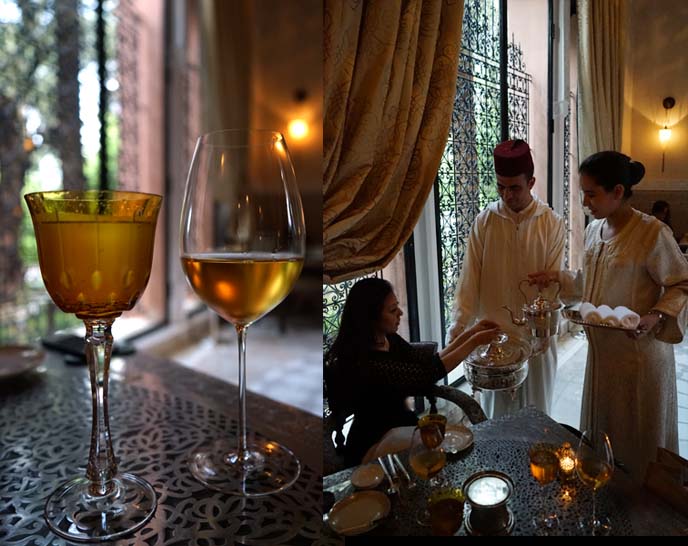
Seamless service, by servers in white gloves. They poured water over our hands as a washing ritual, and served us fine Moroccan wines — above was one of the best glasses I’ve ever had.

We started with our new favorite appetizer, a spread of Moroccan salads with honey and spices.
In the center, we had a selection of pastillas, or savory pies wrapped in crisp pastry. I’m still dreaming of the spinach and cheese one.
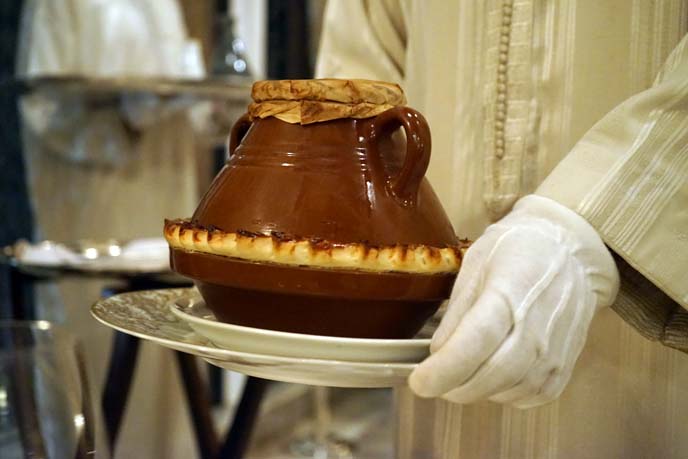
It was hard to choose our main courses, which were based on Moroccan tradition. Tagines, couscous, Moroccan gnocchi, fish served in clay pots. As expected, everything was 5-stars. If only we could have ordered the whole menu…
We loved the desserts with a molecular twist, including an orange blossom concoction with citrus caviar that burst in your mouth.

It was around my birthday… and the staff surprised me with these Grand Budapest-worthy cakes.
The hotel has a clever underground tunnel system that lets staff enter and exit the riad without disturbing your peace. One of them delivered these delights at the exact right moment, and then scurried back into the tunnel like a genie. Amazing.
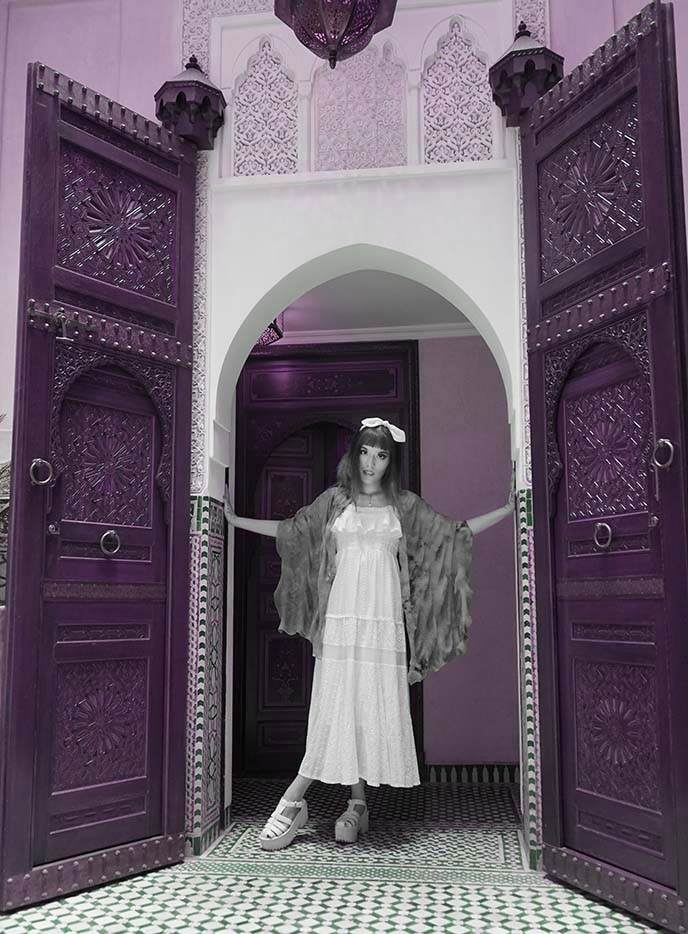
I hope the doors to your imagination are open, after this peek inside Royal Mansour Marrakesh — which deserves its title as one of the leading hotels of the world. The riad just re-opened after a summer renovation, and the gardens have become more enchanting than ever. Learn more and book this hotel here.
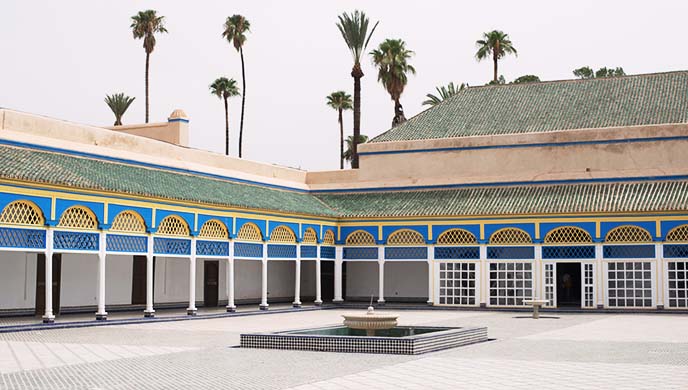
I leave you with a few shots by Joey Wong of Bahia Palace in Marrakesh, built in the late 19th century by a former slave who rose to become the Sultan’s Grand Vizier.
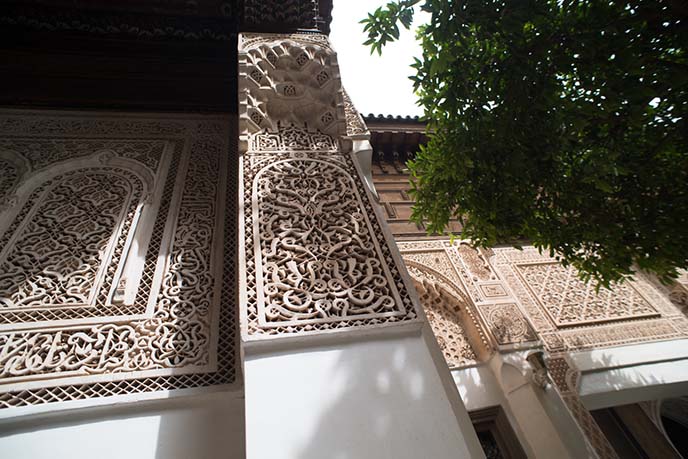
Bahia has a 2 acre garden and harem, decorated with these intricate Islamic reliefs.
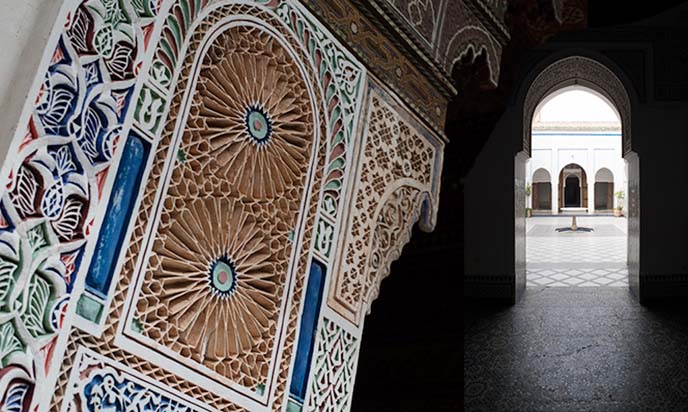
The detailing live up to the palace’s name, which means “brilliance.” Isn’t Moroccan architecture magnificent? I’d jump at the chance to come back and see more of the country.
If you’re planning a trip to Fez, Marrakesh and surrounding cities, check out all my travel tips and articles here. And watch me explore more of Royal Mansour in our Morocco travel video. To book a stay at my riad and see prices, click here.
PS: You’re welcome to Share and Pin these photos, if you felt inspired!
SHARE & COMMENT
Marrakesh Square of the Dead! Snake charmers, Yve St Laurent’s Jardin Majorelle.
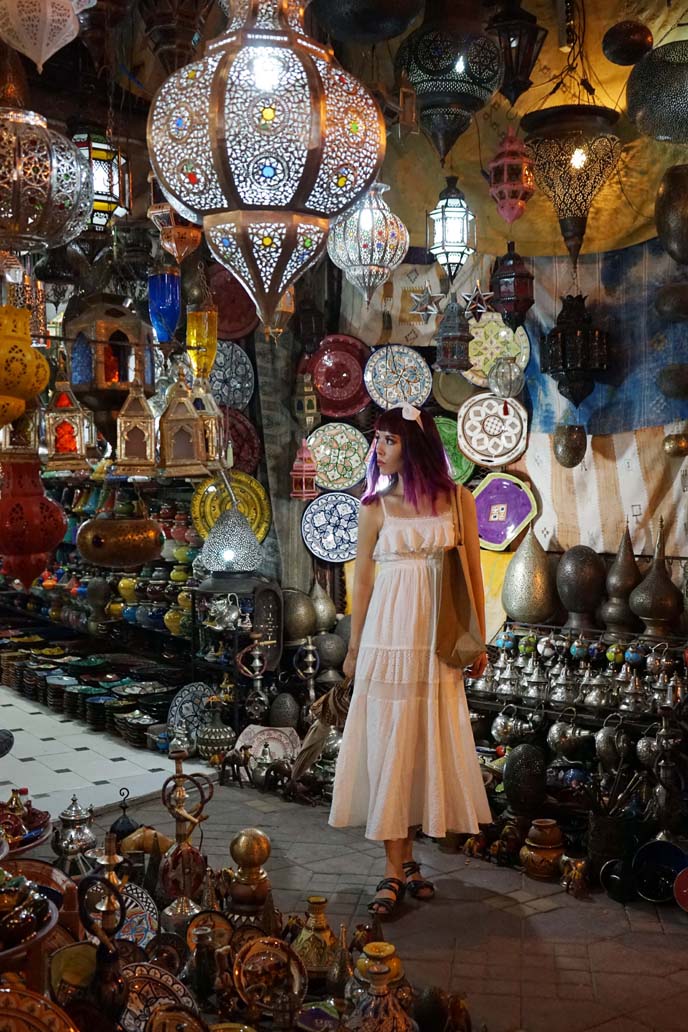
Morocco remains one of my favorite destinations of all time. Plan-It Fez Tours took us on an extraordinary road trip throughout the country, which we captured in this travel video.
I still have a few tales to tell from mysterious Marrakesh. (Doesn’t it look like I am searching for Aladdin’s magic lamp?)
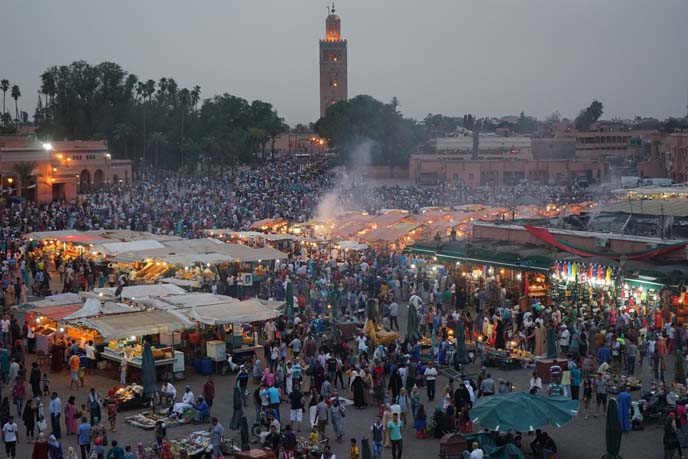
In this photo diary, I’ll share our photos from the Square of the Dead (Jemaa el-Fnaa), which has a dark history to match its name.

We’ll also take a stroll in Jardin Majorelle, the garden of French couture designer Yve Saint Laurent.
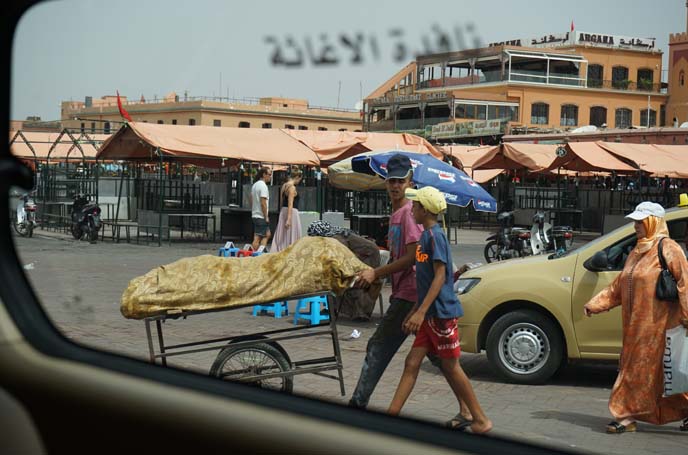
Anyone who comes to Marrakesh must see the ancient marketplace, the Square of the Dead (Gemaa el Fna). The name likely refers to the public executions that took place in this plaza, around the 11th century.
During the daytime, the Square of the Dead is not as crowded. Vendors begin to set up their food stalls in the afternoon.

Even during this less busy time, the Square of the Dead can feel overwhelming to the senses. You’ll encounter monkeys performing tricks, snake charmers sticking out their tongues at cobras, and water bearers in traditional Moroccan costumes.
(Be aware that if you take photos of them, they’ll ask for about a dollar, and won’t let you go until you pay up.)
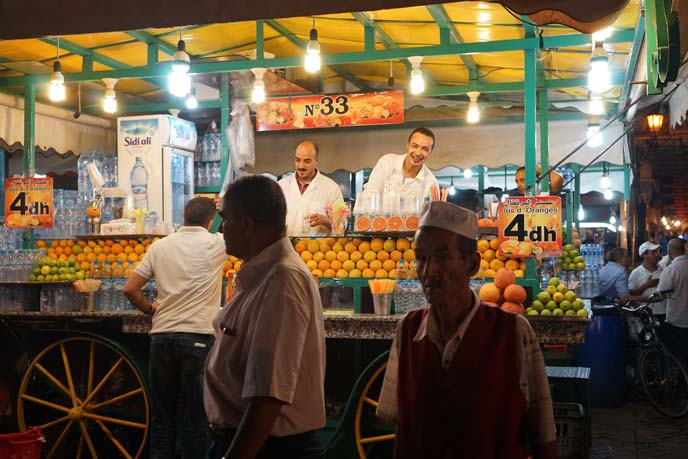
You’ll come across rows of friendly orange juice vendors. The citrus fruits are extremely tasty in Morocco, and refreshing on a hot day. The price for a large, freshly squeezed cup is also a fraction of what you’d pay at an American juice shop.
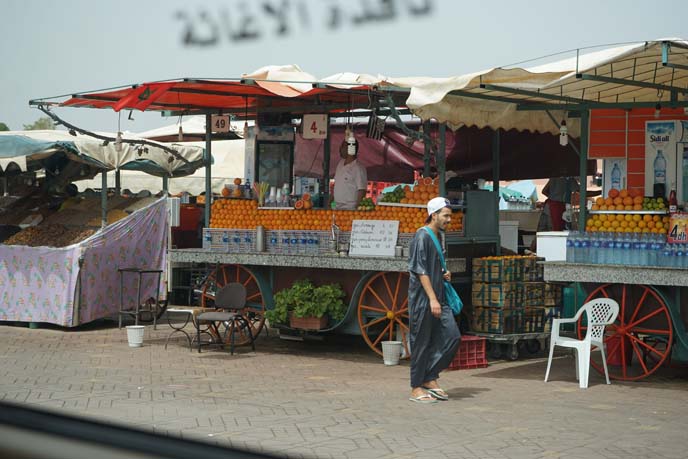
Many readers asked me: is it safe in Marrakesh, especially for solo female travelers?
Yes. The medina is clean and well policed. Just exercise your usual caution (such as giving a firm no to touts, and keeping your belongings secure). Even if you cover up your limbs, you may encounter some cat-calls — simply move on, and don’t let it take away from your experience here.

The marketplace is a bit touristy, but still conveys the feeling of time standing still. Incredible that the medina has been the center of activity in Marrakesh, ever since the 11th century!

We couldn’t resist filming the snake charmers in action. They coaxed the reptiles with music, and put their faces close to cobras who reared their heads and hissed. (Photography by Borderless Media.)

This slithering snake is non-poisonous. This man draped the animal around our heads and shoulders, and encouraged us to stick out our tongues.

There’s a lot to see and shop in the medina. I loved these little tagines, or triangular clay pots that can hold spices or other belongings. Each is only $1 US , so I got some for my cat to use as food bowls!
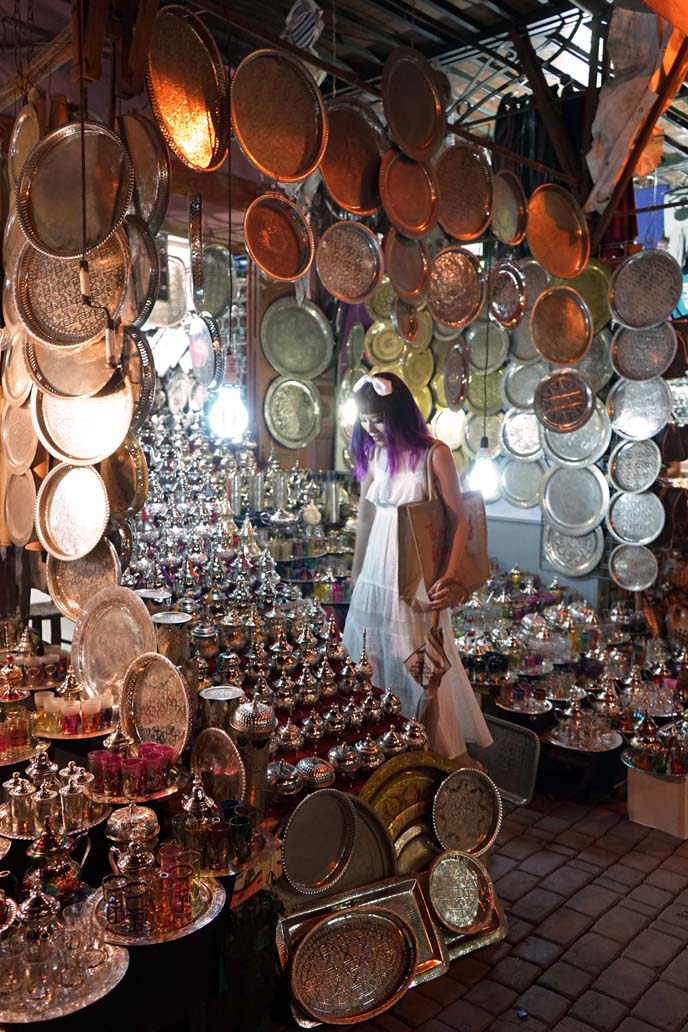
One of these magic lanterns has a genie inside, I’m sure of it…

Night falls, and the Square of the Dead lives up to its spooky name. From a restaurant high up, we took in this fascinating view of the medina. The food stations are open, and smoke wafts over the hoards of people. (Here’s my Vine video of the action.)
The glowing tower is Koutoubia Mosque, which dates back to the 12th century. From the minaret, we heard the muezzin singing the call to prayer — and felt like we had time-traveled back into time.

The souk was filled with strange and mesmerizing sights. We saw locals gathered in a circle to play a game, which involves using tall fishing poles to grab a soda bottle. Like in amusement parks, very few participants succeeded.
As I explored, I felt like I was in a tale from 1001 Arabian nights. We passed Chleuh dancing-boys (who crossdress as women), storytellers, musicians, peddlers and magicians.
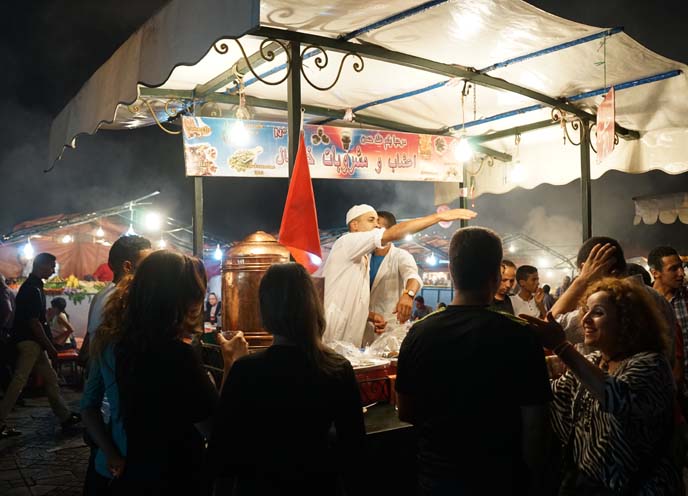
The energy levels are especially high in the food and drink areas. Vendors set up stations in closely-packed rows, and offer everything from mint tea…

… to snails and sheep brains. For the less adventurous eaters, there are grilled meats, dried fruit and nuts, and the ever-present orange juice carts.

The atmosphere can be a bit intense, especially for women traveling alone. Be prepared for stares, and for the vendors to approach you and yell out names (I got called Lady Gaga and Barbie).
Just ignore the words, keep on walking, and don’t let them grab you (as the more aggressive sellers might do).
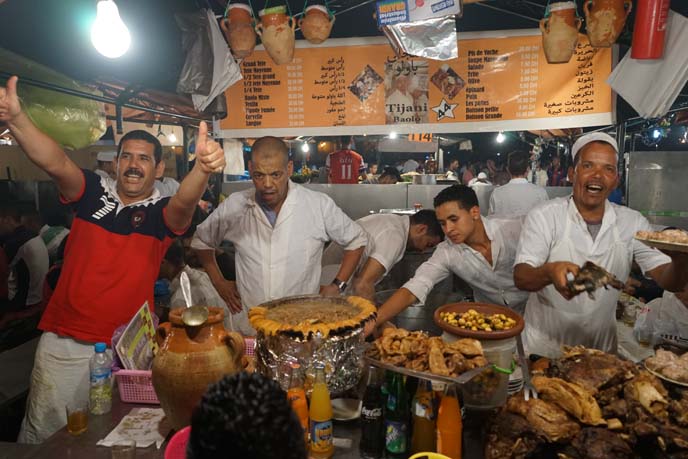
It’s all part of the Marrakesh experience, and I never felt unsafe. (Watch our travel video to see these scenes in action.)

One of the best decisions we made was to travel with Plan-It Fez Tours. I spoke with friends who did Morocco on their own, and they told me they felt stressed by logistics such as public transportation. They told me about taxi drivers who tried to scam them, and touts who constantly approached them.
Thanks to our friendly driver and guides, we encountered none of these complications.

With a car, we got to visit off the beaten path places — such as Berber villages several miles from Marrakesh. Our Plan-It Fez guides introduced us to locals and translated Arabic, making immersive activities such as a henna workshop possible.
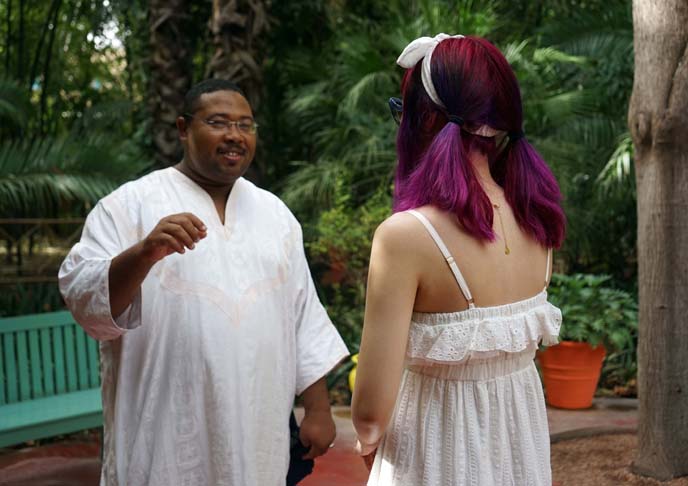
We visited Jardin Majorelle, which was designed by artist Jacques Majorelle in the 1920s and 30s. Our guide Mohammed told us about the fascinating history of Marrakesh, from its earliest days through the French protectorate and independence.

The red paths are surrounded by cacti plants and calm pools dotted with water lilies. Birds call out from under the palm canopies.
The winding garden pathways lead to the French artist’s house, built in Moorish and Art Deco styles. The bold cobalt blue color, which brightens up the entire property, is called Majorelle Blue.
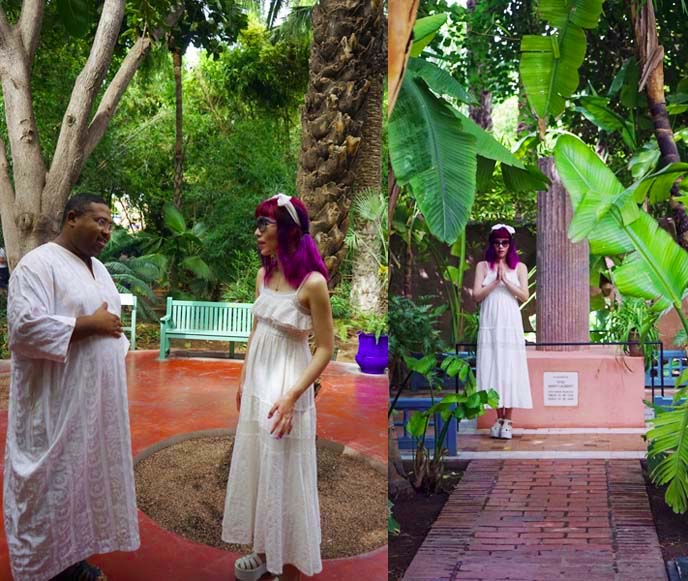
Since 1980, Majorelle Garden was owned by fashion legend Yves Saint-Laurent and Pierre Bergé. I visited the gravestone of YSL, who died in 2008.
To be honest, I wasn’t blown away by Jardin Majorelle. There were a lot of tourists around, and I was more impressed with the lush landscapes at our Royal Mansour hotel. Nevertheless, I enjoyed spending time here with the jovial Mohammed, and seeing St Laurent’s illustrations in a special art display.
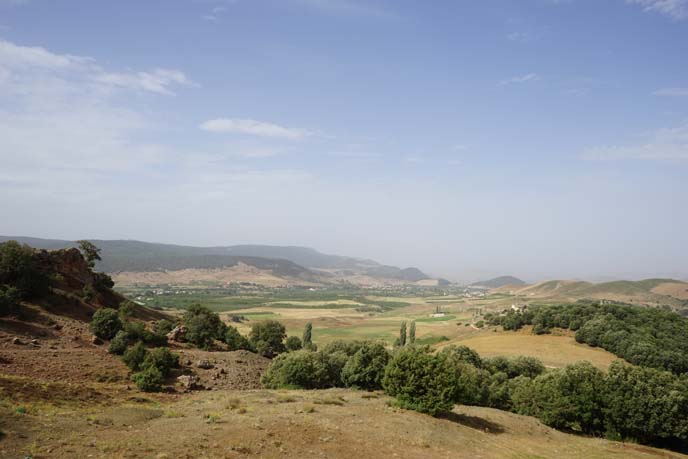
Sometimes, the best travel moments are not from visiting famous attractions — but merely sitting back and enjoying the ride. Nowhere but in Morocco can you see views like these: the High Atlas mountains and argan trees.
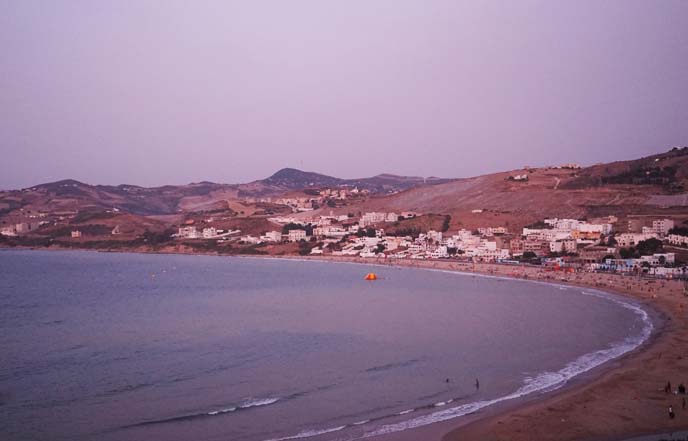
We originally came to North Africa by taking the ferry from Algeciras (southern tip of Spain) to Tangier (northernmost point of Morocco). Plan-It Fez picked us up, and we began a road trip along the coast.
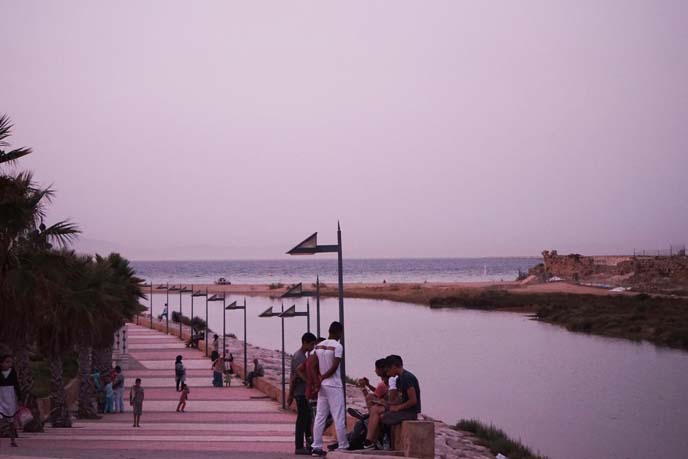
From these first moments, we were fascinated by the contrast of ancient and modern. We saw glitzy nightclubs pumping with music and women in sequined headscarves on the boardwalk… and then turned into the Tangier medina, which looked like scene from Medieval times.

The sun set over the waters, turning the sky blood red.
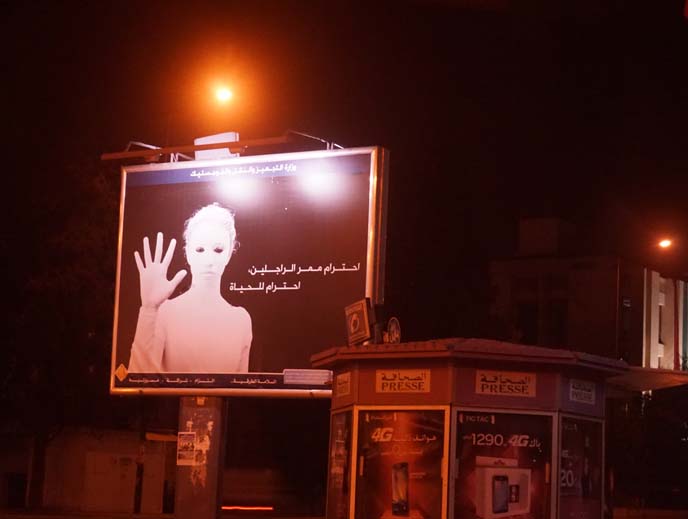
As the hours on the road passed, we drifted into semi-sleep. The car zipped by this alien-esque Arabic poster, and I wondered if I was in a dream.

I leave you with this image of the lively Square of the Dead, at dusk.
Is Marrakesh what you expected it to be? I hope you enjoy our Morocco travel video – please take a minute to watch, and let us know what you think!
 LA CARMINA
LA CARMINA






